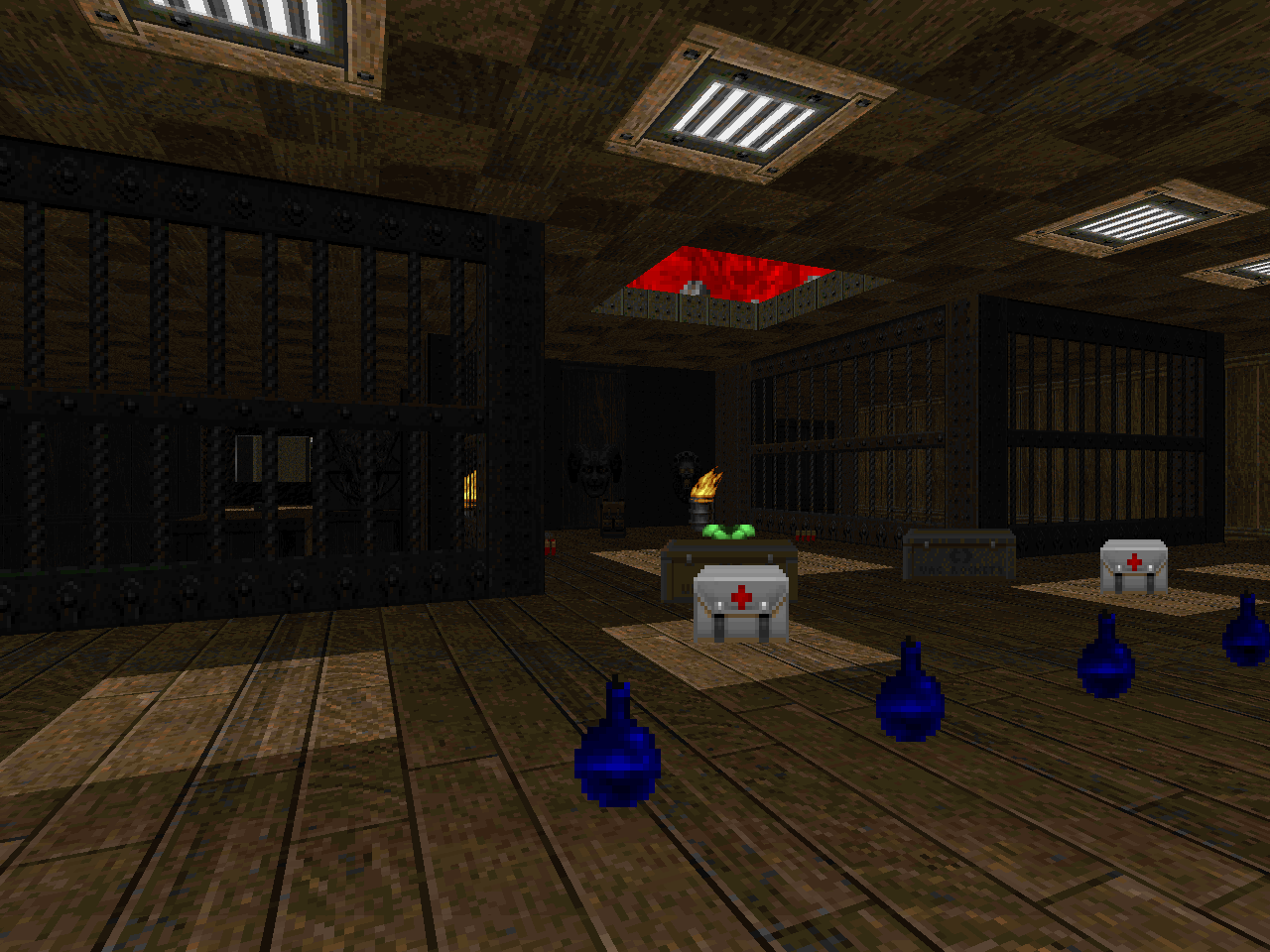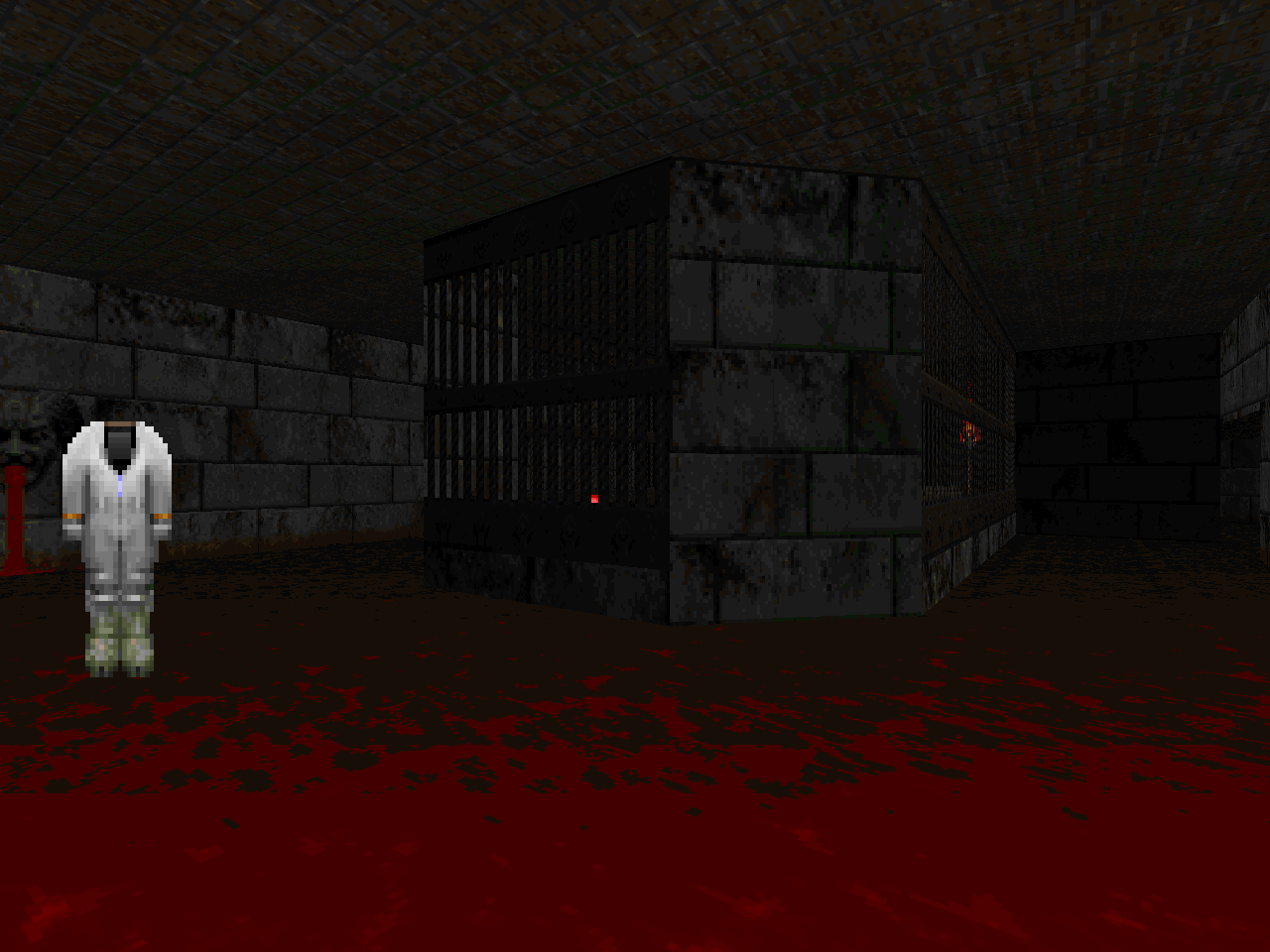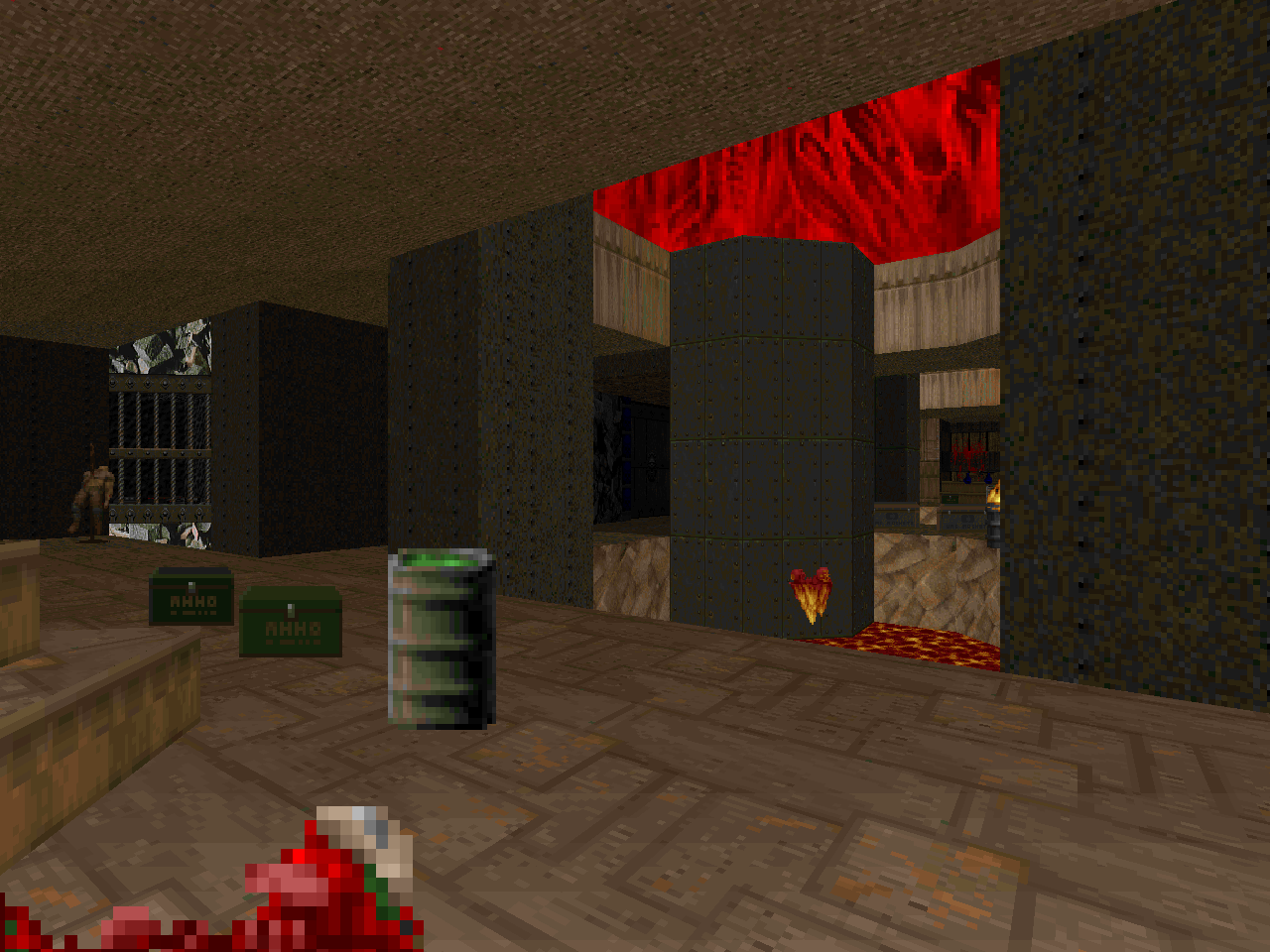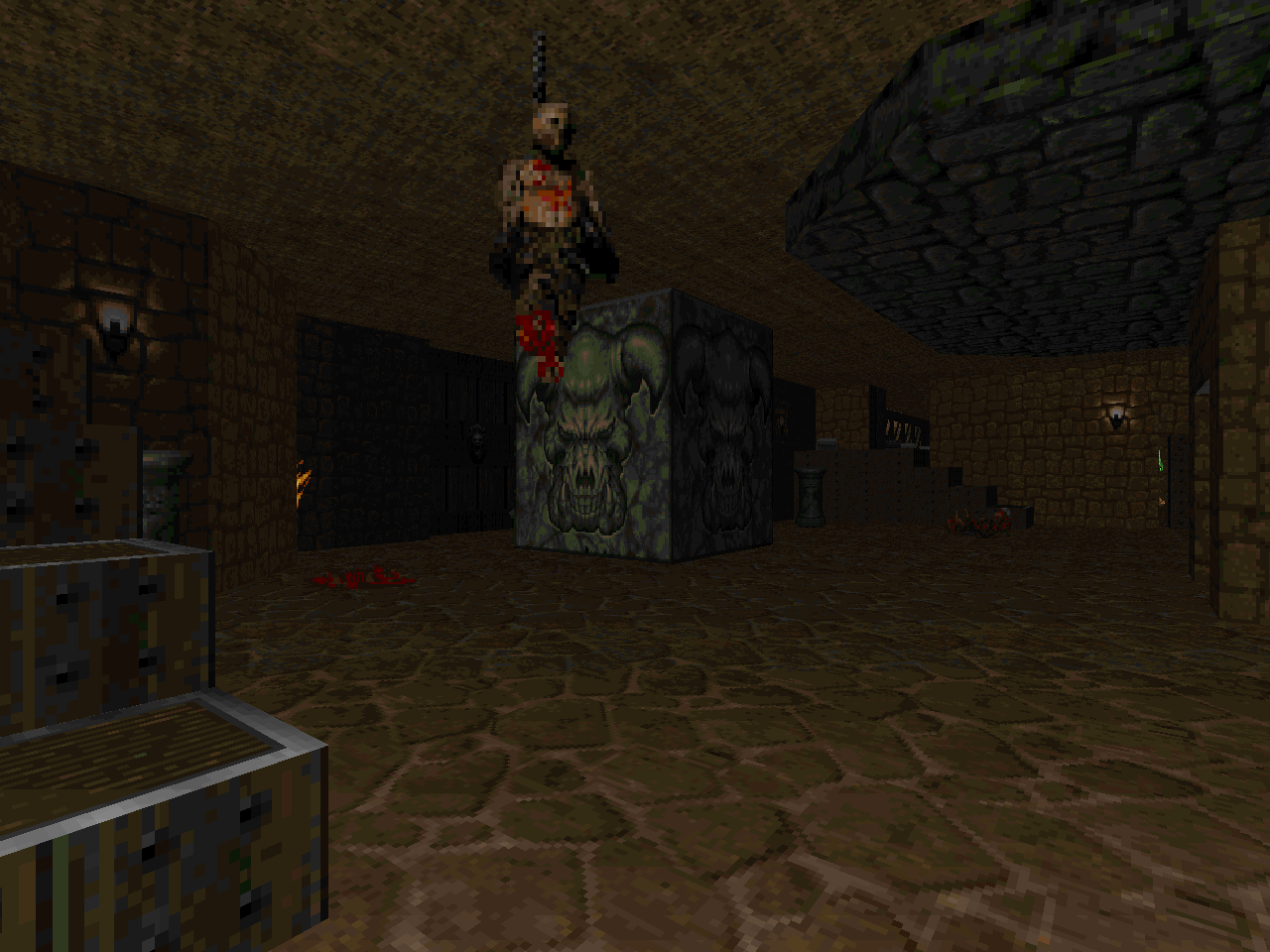HELL PIT
by Mike Alfredson aka "Use3D"
Mike's most recent release was as part of Ultimate Doom the Way id Did but he's been a low key contributor to big names like the Community Chest series and Back to Saturn X. Not to forget the original DtWiD, of course. All of his solo single-level publications are effectively archival releases and generally old ones at that, either from the category of "Nilla Doom reject" or "old level that predates Nilla Doom". I assume, anyway, as the former levels go out of their way to say that they were made for and then cut from the running order of his in-development megaWAD. Like Soulcage, Hell Pit is a map from the latter category, a Doom II MAP26 replacement that was handcrafted back in 1996 only to be uploaded much later in early 2004.
This early level does not come with a story but it makes a point of using the same slot as "The Abandoned Mines". I'm sure that this is mostly due to the sky (Hell Pit, of course) and the track that Alfredson preferred for the level, in this case "Message For the Archvile". The exit portal matches up with the aesthetic seen in Doom II's Hell episode so it's pretty clear that it takes place in, well, Hell. The presence of UAC crates seems to suggest that the location is a UAC base, perhaps one subsumed into the inferno. It's also possible that the base was foolishly established as a foothold for further research.
Soulcage had a motif, stretched though it may seem at first glance, of restricting monster movement as well as - occasionally - yours. Hell Pit has a similar gameplay theme in that the player must descend time and time again in order to achieve any real progression. The opening wood and metal Hell chamber has dual staircases that descend into giant pits. Going down and west, you must further ride an elevator into poisonous muck in order to get the red key. Down and to the east, you are forced to descend and then trudge through a toxin-swamped marble ruin / ancient sewer in a quest for the yellow key. The nexus of the level and its id-like symmetric core occurs on the same general plane, with the damage floor now being a lethal hazard, but there are dual descending staircases that lead to an outdoor UAC warehouse.
As I started looking at this level for the post-playthrough review I began to feel something of an echo of Thy Flesh Consumed, chiefly Tim Willits's "Fear" (E4M9). It may not be mere coincidence that Use3D's UDtWiD contribution is a similarly-themed level in the same slot ("Terror", E4M9). The strongest similarity I think is found in the northern, walled crateyard area with the opposed, overlooking balconies. The overall combat is quite different, of course, given that there is a great big fuckoff Cyberdemon stomping around the platform. Between this and the multiple mirrored staircases, however, I believe that there's good reason to suspect that Alfredson was inspired by Willits's design.
The cultured bane of any level that makes heavy use of symmetry in its architectural design is how closely said symmetry is adhered to. This avenue of critique feels founded upon authorship principles that attempt to maintain users' interest through visual and encounter variety. Up until now I had never really considered whether players might felt relieved when they could correctly anticipate encounters and traps through predictive symmetry. There is too much of the funhouse adventurer in me to not be, at times, slightly bemused when knowing removes most of if not the entirety of the challenge. To make an extremely hypothetical case that demonstrates the critic's point, I would not be particularly enthused to play a level that consisted entirely of a hub and four identical, copy-and-pasted wings.
Much of the fun of playing PWADs comes from having a nearly limitless supply of user content to play through. A lot of this is in the form of brand new geometric creations but there are plenty of levels that succeed by overtly leveraging older ideas, similar to how music tracks are remixed or remade. In the latter case, a key attraction is in having something identifiably familiar and seeing what similarities or differences exist. This is a selling point of the Switcheroom series, with the originals being recontextualized in the themes of different episodes. On the smaller scale, authors tend to break symmetry by using detailing or monster placement. In some cases they take advantage of past experience - dictated by the authors themselves - in order to lull players into a false sense of security. There may be a trap where on the other side there had been none, or the contents of the monster closet are markedly more severe.
Hell Pit is pretty straightforward in how Alfredson decides to deal with the symmetry of the level's main body. The thing placement in the connective tissue has a lot of overlap but there are plenty enough deviations to subvert player expectations. Say, having a commando in one of the starting pits and a small flock of lost souls in the other. The contents of the monster cages on either side of the blue skull door are somewhat varied, with imps on one side and shotgun guys on the other. The dual platform rooms to the south-west and -east of crate yard have some minor detailing and initial monster kit differences. More importantly, one of them is hooked up via teleporter pad to admit creatures from the western balcony. As a fun bit of design, the character of this particular trap points the way for the player.
It's a monster-heavy level but Use3D is up-front about giving you both the super shotgun and plasma gun very early on. Confidentially, there's even a hidden BFG right at the start (!). Mike is also keen on providing you a ton of ammo, most of it laying around in plain sight. Some of the combat has a sort of hornet's nest vibe to it, particularly the storage yard and the surrounding balconies / rooms. There are hitscanners everywhere, not to mention the Cyberdemon. These together with the other entrenched beasties strongly suggest a tactical approach. There's one big pitched teleporter ambush about halfway through the level, inside the catwalk criss-crossed lava room. The terrain makes things a little tricky when attempting to outmaneuver your foes but it's a single-destination assault, greatly simplifying matters.
Hell Pit has a bit less of the dungeon crawler feel that Soulcage more or less exemplified. A lot of this comes from to the open-air / bunker shootout of the final area. I think that it's still pretty strong in the first half, though Use3D has injected more of a sense of urgency to the first two wings by putting enviro suit timers on your exploration and combat times. There's one weird bit that Alfredson mentions specifically in his .TXT; he obviously took the time to replay his then eight-or-so-year-old creation and then promptly disgusted himself. The coda of the level takes place once you press the blue key switch and is classic case of cryptic progression. It doesn't open up the blue skull door but rather a nondescript teleporter that returns you to a previously inaccessible portion of the map. From here you get a three-way save or die trap with gore objects serving as an obtuse clue as to the correct way forward.
Use3D delivers yet again with another wicked cool classically-styled PWAD that both looks good and plays pretty well. I'm stoked to see what his Nilla Doom rejects look like, given that these older maps have been rock solid blastathons. If you enjoy the '95-'96 era of the Doom community then you absolutely need to give Hell Pit a try.

I CAN'T HELL PIT










No comments:
Post a Comment